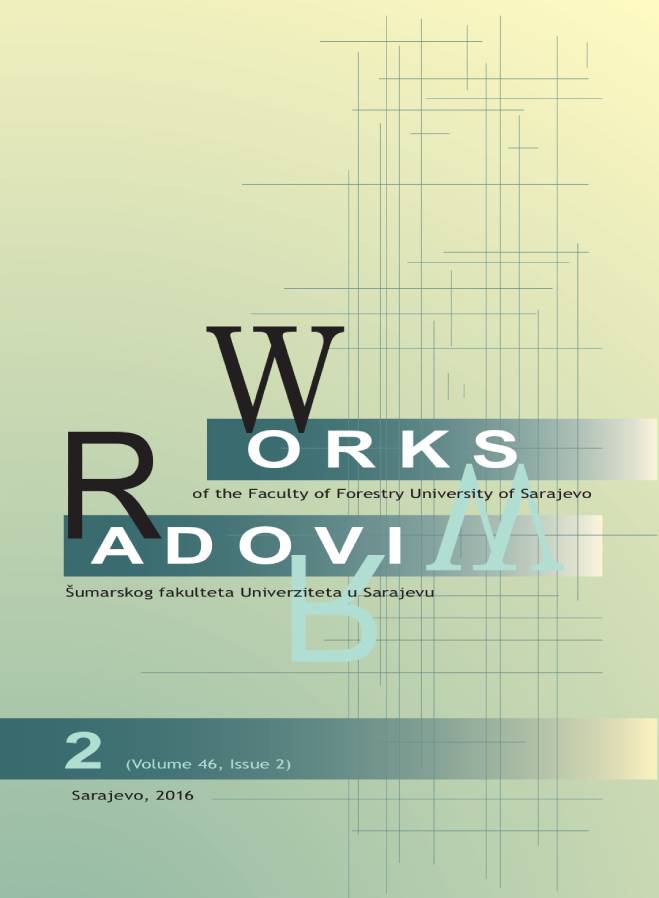EVALUATION OF MLR AND GWR REGRESSION MODELS OF CURRENT ANNUAL INCREMENT PREDICTED BY GROWING STOCK, TOPOGRAPHICAL AND LANDSAT 8 SPECTRAL DATA IN THE NORTHEAST BOSNIAN MIXED FOREST
DOI:
https://doi.org/10.54652/rsf.2016.v46.i2.70Keywords:
current annual increment, structural and environmental predictors, Landsat 8, ordinary and geographically weighted regressionAbstract
UDK: 630*52/*56:519.8(497.6)
The aim of this research was to evaluate estimates of the current annual increment of volume (CAIv) variability considering growing stock (V) as structural variable and topographic conditions and Landsat 8 spectral response as environmental variables on hilly and mountainous mixed forests in the northeast Bosnia using multiple linear regressions based on ordinary least squares (MLR) and geographically weighted regression (GWR).
Sample data contains geo-referenced forest inventory data, CAIv (m3/ha/year) and V (m3/ha), extracted values from digital terrain model (altitude, slope and aspect) and derived principal components values from Landsat 8 satellite image for forest stands of the management unit located on hilly and mountain positions in protected area Konjuh, Kladanj. Here are applied MLR and GWR using stepwise procedure. MLR and GWR analyses resulted with global coefficients of significant predictors on hilly position. This was expected due to homogenous vegetation and environmental conditions on hilly position. It was found that growing stock affected CAIv the most. Significant improvement of regression modeling is achieved by GWR appliance on sample from mountainous position. There were obtained local influence of growing stock and the first principle component related to green biomass on CAIv. The highest improvement is found for broadleaves CAIv where quantification of local variability of growing stock increased adjusted coefficient of determination about 11% and reduced relative root mean square error for 6%. Local character of green biomass related to conifers CAIv did not improve regression estimation significantly. The broadleaves root mean square error based on GWR was 1.60 m3/ha/year (coefficient of variation more than 30%) which is still high so further modeling including other structural characteristics (stems number, basal area, mixture) as predictors is required.
Downloads
References
AUSTIN, M. (2007): Species distribution models and ecological theory: A critical assessment and some possible new approaches. Review. Ecological modeling. 1-19.
BENÍTEZ, F. L., ANDERSON, L. O. AND FORMAGGIO A. R. (2016): Evaluation of geostatistical techniques to estimate the spatial distribution of aboveground biomass in the Amazon rainforest using high-resolution remote sensing data. Acta Amazonica. Vol. 46(2): 151- 160.
CHARLTON, M., FOTHERINGHAND, S. AND BRUNSDON C. (2006): Geographically weighted regression. Esrc National Centre For Research Methods. Ncrm Methods Review Papers Ncrm/006.
CIENCIALA E., RUSS R., SANTRUCKOVA H., STÅHL G. (2016): Discerning environmental factors affecting current tree growth in Central Europe. Science of The Total Environment 573: 541-554.
ČABARAVDIĆ A., OSMANOVIĆ M., MAHMUTOVIĆ G., MULIĆ S. (2016): Geostatistical Technique for Growing Stock Estimates on Small Forest Stands Using Inventory, Environmental and Landsat 8 Data. Works of the Faculty of Forestry University Sarajevo, 46(1), 1-13.
ČERMÁK P., RYBNÍČEK M., ŽID T., ANDREASSEN K., BØRJA I., KOLÁŘ T. (2017). Impact of climate change on growth dynamics of Norway spruce in south-eastern Norway. Silva Fennica. Vol. 51(2): 16.
LEMPEREUR M., MARTIN-STPAUL K. N., DAMESIN C., JOFFRE R., OURCIVAL J. M. (2015): Growth duration is a better predictor of stem increment than carbon supply in a Mediterranean oak forest: implications for assessing forest productivity under climate change. New Phytologist. Vol. 207(3): 579–590.
MARTÍN-QUELLER E., GIL-TENA A. and SAURA S. (2011): Species richness of woody plants in the landscapes of Central Spain: the role of management disturbances, environment and non-stationarity. Journal of Vegetation Science 22: 238–250.
NAKAYA, T. (2014): GWR4 User Manual: Windows Application for Geographically Weighted Regression Modelling. GWR4 Development Team.
PROPASTIN, P., KAPPAS, M. AND ERASMI, S. (2008): Application of Geographically Weighted Regression to Investigate the Impact of Scale on Prediction Uncertainty by Modelling Relationship between Vegetation and Climate. International Journal of Spatial Data Infrastractures Research, Vol. 3, pp. 73 – 94.
RAIS A., VAN DE KUILEN J.W., PRETZSCH H. (2014). Growth reaction patterns of tree height, diameter, and volume of Douglas-fir (Pseudotsuga menziesii [Mirb.] Franco) under acute drought stress in Southern Germany. Eur J 133(6): 1043–1056.
RANGEL, T.F.; DINIZ-FILHO, J.A.F. AND BINI, L.M. (2010): SAM: A comprehensive application for Spatial Analysis in Macroecology. Ecography, 33: 1-5.
SHRIESTA, P. M. (2006). Comparison of Ordinary Least Square Regression, Spatial Autoregression, and Geographically Weighted Regression for Modeling Forest Structural Attributes Using a Geographical Information System (GIS)/ Remote Sensing (RS) Approach. Master thesis. Department of Geography Calgary, Alberta. University of Calgary.
TIRYANA, T., TATSUHARA, S. AND SHIRAISHI, N. (2010): Modeling Spatial Variation in Stand Volume of Acacia mangium Plantations Using Geographically Weighted Regression. FORMATH, Vol. 9, pp. 103 – 122.























